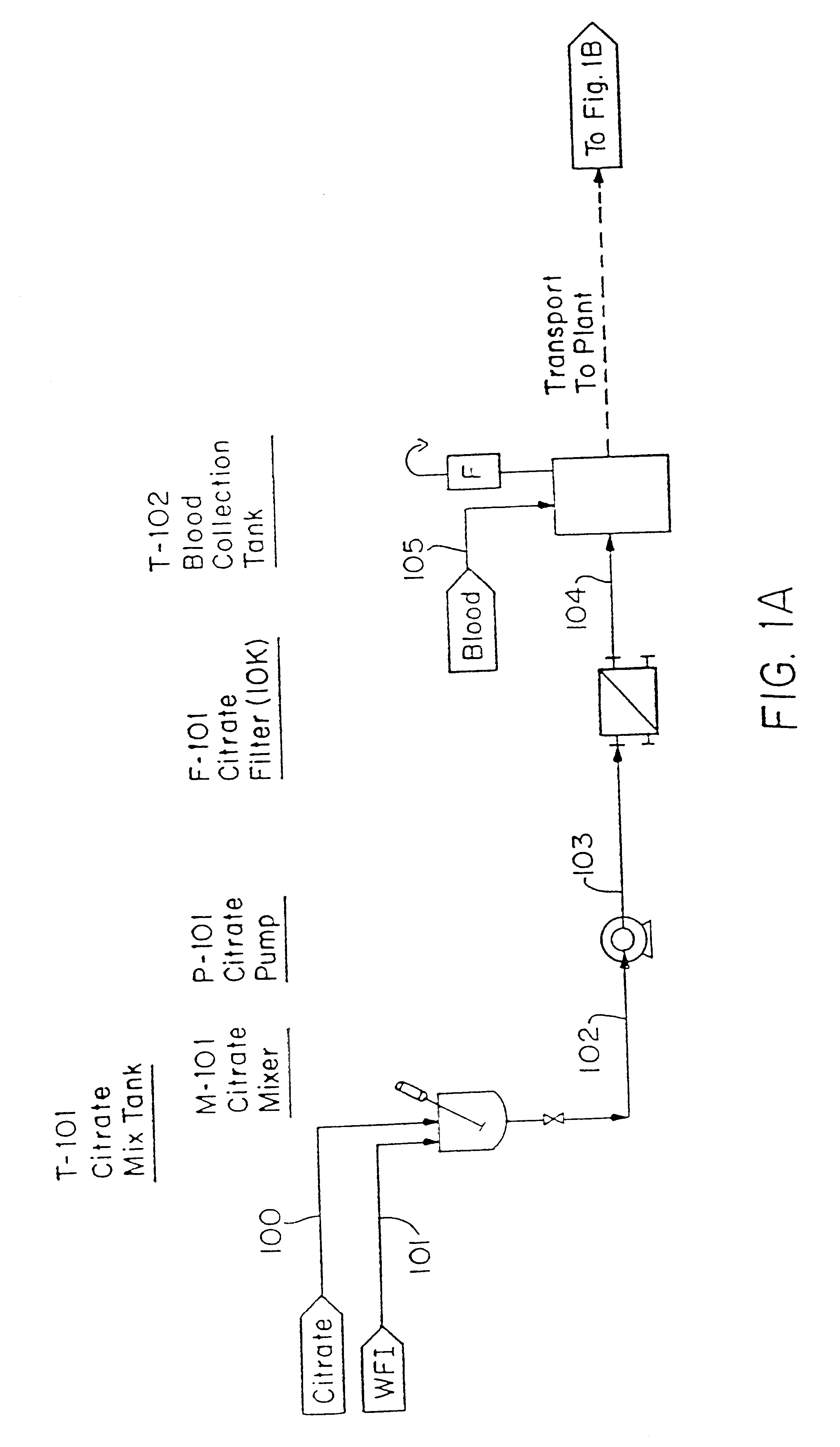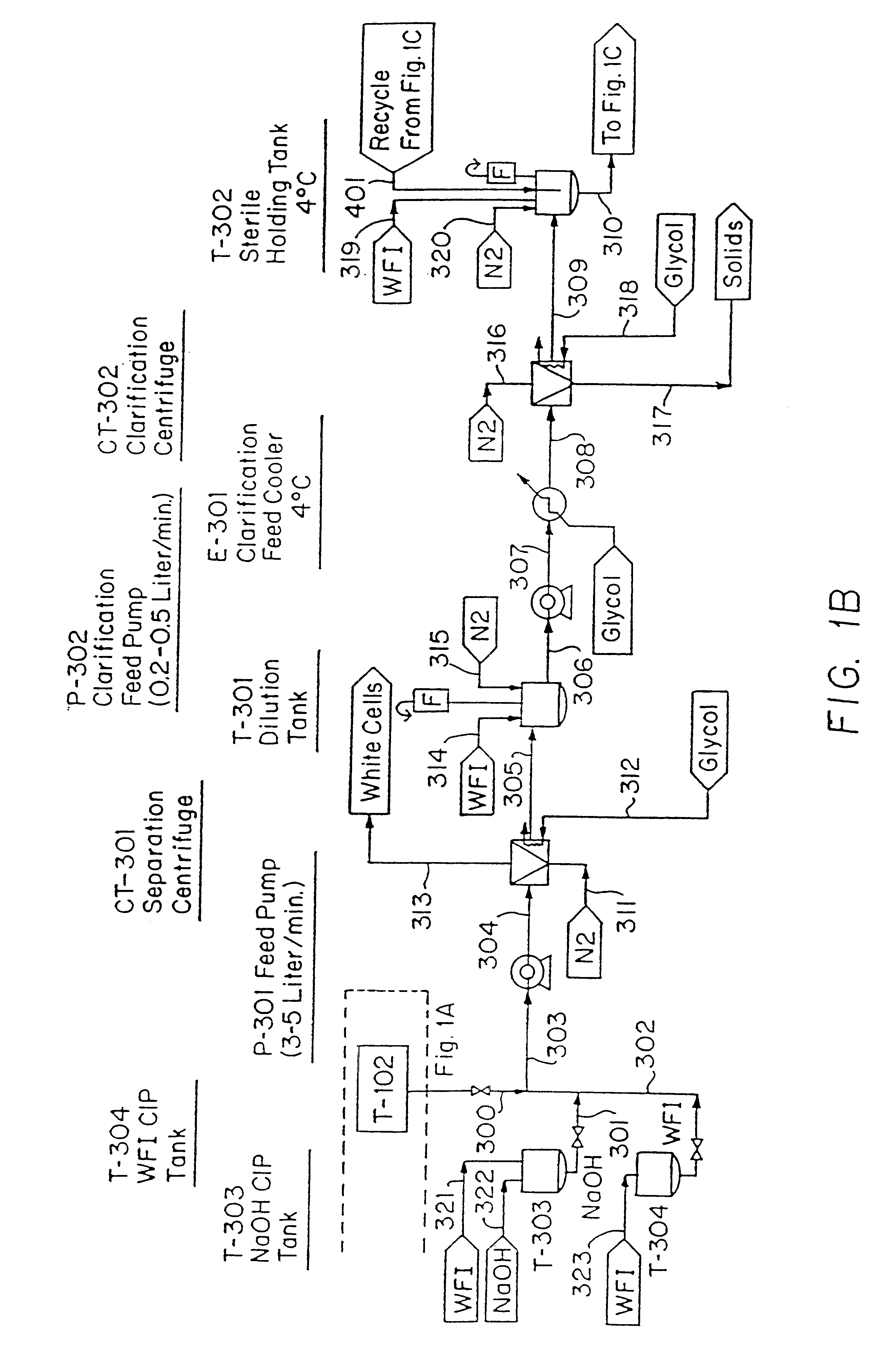Ultra pure hemoglobin solutions and blood-substitutes
- Summary
- Abstract
- Description
- Claims
- Application Information
AI Technical Summary
Benefits of technology
Problems solved by technology
Method used
Image
Examples
example i
The Blood Production Process
In the following Example, the equipment identified in parenthesis is further identified in the reference list which follows. FIGS. 1A-1H are a flow sheet for the process of this Example, with the equipment reference numbers of the Example corresponding to the Figure reference numbers.
Erythrocytes (red blood cells) were obtained from the blood of slaughtered cows. Because of its ready availability, the bovine blood obtained from slaughter houses is the preferred erythrocyte source.
Collection trochars were used to extract the blood in a sterile manner; the animal hide is cut, peeled back and the trochars then inserted in the animal's major vessels close to the heart. The introduction of bacteria was avoided and the maintenance of pyrogen-free or low-pyrogen level material was accomplished using a container, specifically Blood Collection Tank (T-102), which was precharged with depyrogenated sodium citrate as anticoagulant (0.5 liters). A s...
example ii
Molecular Weight Distribution
This study was undertaken to determine molecular weight distribution of final product. Hemoglobin particles with M.W. more than 1,000,000 might cause some clinical problems in human and animals. One ul of final product (80 ug of protein) was diluted by 50, and this 50 ul was injected into Hewlett-Packard HPLC System. Water Data 740 Module Station was used to integrate results.
Since 1980 the classical gel filtration technique employing soft and semirigid organic gels for protein characterization and purification has received progressively greater competition from high-performance size-exclusion chromatography (HPSEC). The breakthrough of HPSEC is associated with the development of highly efficient buffer-compatible columns operating at elevated back pressure. The columns are packed with rigid hydrophilic porous silica gel particles of pre-determined pore size distribution and a derivatized protein-compatible surface. The proteins elute in the sequence of ...
example iii
Endotoxin Concentration Determination
The detection of endotoxin concentration within a cross-linked blood sample was tested by using the Limulus Amebocyte Lysate (LAL) Assay test. The LAL has been obtained from the extracts of the amebocytes of the horseshoe crab. The sample was tested to be positive or negative and was determined as such against an end-point reaction made by a series of dilutions of a reference endotoxin. A standard regression curve was made from colorimetric readings from the above-mentioned dilutions and the endotoxin content was determined from the interpolation from the curve.
On Jan. 18, 1980 (38 FR 1404), the FDA announced that Limulus Amebocyte Lysate derived from amebocytes of the horseshoe crab is now a biologic product and can be used in place of rabbits. LAL has proved to be a sensitive indicator of bacterial endotoxin or pyrogens within the product. Because of its high sensitivity in detecting endotoxins, products can be prevented from being administered...
PUM
| Property | Measurement | Unit |
|---|---|---|
| Size | aaaaa | aaaaa |
| Temperature | aaaaa | aaaaa |
| Volume | aaaaa | aaaaa |
Abstract
Description
Claims
Application Information
 Login to View More
Login to View More - R&D
- Intellectual Property
- Life Sciences
- Materials
- Tech Scout
- Unparalleled Data Quality
- Higher Quality Content
- 60% Fewer Hallucinations
Browse by: Latest US Patents, China's latest patents, Technical Efficacy Thesaurus, Application Domain, Technology Topic, Popular Technical Reports.
© 2025 PatSnap. All rights reserved.Legal|Privacy policy|Modern Slavery Act Transparency Statement|Sitemap|About US| Contact US: help@patsnap.com



